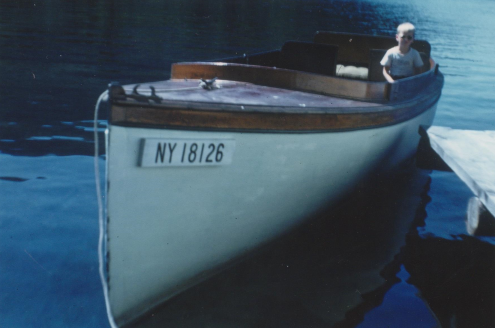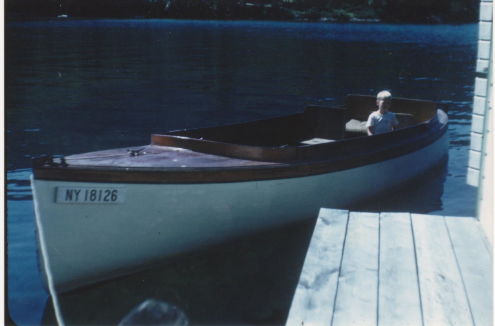To celebrate Christmas, I offer a short video below about the Church of the Navity in Bethlehem which has the greatest historical significance to Christians throughout the world. I would also like to wish you and your family a very Merry Christmas. May you be at home with the ones you love.
Gift Idea: Water & Light – S.R. Stoddards Lake George

The cover of Water & Light, a new book of Seneca Ray Stoddard’s photos of Lake George. (Available in hard cover or soft cover.)
The Chapman Historical Museum is offering for sale a wonderful new book comprised of the best Seneca Ray Stoddard photos from its collection. Stoddard, who photographed Lake George in the 1870’s to 1890’s, captured fantastic views of the lake’s hotels, islands and dramatic shorelines.
With an introduction by historian Joseph A. Cutshall-King, the book contains 150 inspiring and original photos of Lake George and its surroundings. It can be purchased from the Chapman Museum online store.
An Aerial View on ‘Black Friday’
 An aerial view of Huletts, taken on Thanksgiving day, November 23, 2017. (Click to see full-scale.)
An aerial view of Huletts, taken on Thanksgiving day, November 23, 2017. (Click to see full-scale.)
While you are hopefully enjoying “Black Friday”, preferably from in front of a computer screen, here is an aerial view of the Landing, taken from above Burgess Island. (Many thanks to Liam Ballantyne for the photo.)
Stanley R. Barber: R.I.P. December 19, 1917 – November 06, 2017
I was sorry to learn of the death of Stanley Barber this past week, 44 days shy of his 100th birthday. Stanley was born Dec. 19, 1917 in Dresden, N.Y., he was the last surviving child of the late Royden and Eunice Barber.
Royden Barber, was instrumental in selling the first Hulett hotel to William H. Wyatt. (Which is detailed in my book: The Hulett Hotel Fire on Lake George.) Stanley’s Aunt and Royden’s sister, Cora Barber, was married to Henry Buckell. The Buckell’s owned and operated the original Hulett hotel.
I interviewed Stanley in 2012 about growing up in Dresden in the early 1900’s. His thoughts on aging and never giving up are worth re-reading in his interview with me.
I learned much about the history of Huletts Landing and Dresden from Stanley Barber and found him to be a delightful and engaging fellow. He will be missed by those who knew him.
Nine Years Old

Well, here it is – another November 9th. Today is the day I celebrate the “birthday” of the Huletts Current. It’s now been exactly nine years since my first post in 2008. Today, when checking the logs – we get readers from all over the United States and the world. I think this comes back to the fact that so many people love Huletts Landing and Lake George and it is truly a community of people who care about each other who want to stay informed. It’s a unique place in this crazy world of ours.
There were times this past year when I couldn’t devote as much time to the blog as I would have liked but don’t fear I’m still going strong. I’m always looking for new ideas, news, and “goings-on” to post. I enjoy learning from you and sharing your thoughts and pictures about Huletts. I count on you – to send in pictures and news that other’s would want to see. I’m thankful for all those who have made the site so successful.
As is my custom, here are the most read posts from the past year.
1.) More Pictures of the HLVFC Response to September 15th Truck Rollover
2.) Megan Kennelly and Greg Leonardi Married in Huletts
3.) Rescue on Black Mountain
4.) Couple Celebrates 60th Wedding Anniversary
5.) Dresden’s New Veteran’s Sign Unveiled
6.) Huletts Landing Volunteer Fire Department Practices Ice Drill
7.) Pictures from the 2016 HLVFC Christmas Party
8.) Third Annual Firemen’s Appreciation Dinner a Great Success
9.) Now For Some History: Arthur Wyatt’s Fay & Bowen Boat
10.) Message from Fire Chief on Sunday Morning Bluff Head Event
So thanks again for reading and now onto year ten!!
Memories of Family Movie Night?

The movie, Last of the Mohicans, with Randolph Scott and Binnie Barnes, was one of the movies shown in the Casino on “Family Movie Night” in the 1950’s.
During the 1950’s, 60’s and 70’s family movie night was a staple in the Casino. Movies such as: Cheaper by the Dozen, Robin Hood, Last of the Mohicans (the 1936 edition), and many Disney classics were enjoyed by many. I remember my parents ordering the films from a catalog and running off the mimeographed sheets advertising these. I recently came across a copy of Chitty Chitty Bang Bang and remembered watching it in the Casino as a child.
If you have any favorite movies you remember seeing in the Casino during family movie night or memories you wouldn’t mind sharing here, I’d appreciate hearing from you.
Fort Ticonderoga Acquires Rare Muskets
Fort Ticonderoga has recently acquired three British muskets that last served at Fort Ticonderoga 240 years ago. Three muskets carried by the 53rd Regiment of Foot are a part of one of the most exciting moments of the Revolutionary history of Ticonderoga and are rare examples of British military firearms from the Revolutionary War.
“The muskets are all marked with a series of numbers and letters that indicate their use with the 53rd Regiment beyond any doubt, even indicating the company and soldier they were carried by. Such information allows the Fort Ticonderoga Museum to say with confidence that these muskets have come back where they saw action 240 years ago,” said Matthew Keagle, Fort Ticonderoga’s Museum Curator. “A single such survivor is rare, for three weapons to emerge is almost unprecedented. The important history of these weapons has been acknowledged through their past loan to the museum, now they will permanently be joining the collection where they will be on display for visitors every day.”
In addition to their legacy at Ticonderoga, these muskets are also important examples of British military long arms from the late 18th century. Noted arms researcher Bill Ahearn first identified these as a unique pattern of weapon, produced in Ireland specifically for the 53rd Regiment. Although similar in their overall appearance, the exact proportions and details of these weapons make them distinct from any other British military weapon from the period.
About the 53rd Regiment of Foot:
General John Burgoyne’s British and German army captured Fort Ticonderoga in July of 1777. By August, the garrison consisted of Germans of the Brunswick Regiment Prinz Friedrich and the British 53rd Regiment of Foot, and then later were spread out across Mount Independence in Vermont all the way to the modern town of Ticonderoga, the head of Lake George, and the summit of Mount Defiance. An American raid on September 18 caught them off guard and succeeded in capturing four companies of the 53rd, Mount Defiance and its artillery, and freed American prisoners of war held by the British. Despite these initial successes, they were not prepared for a formal siege and after four days, the Americans withdrew, leaving the fort in British hands until early November.
Now For Some History: Arthur Wyatt’s Fay & Bowen Boat

Arthur Wyatt’s Fay & Bowen after being repaired circa 1940. Larry Nash (age 5) is seen in the boat. (Click image to see full scale.)
Fay & Bowen 25 ft. Motor Boat Formerly Owned by A. H. Wyatt
This boat was originally owned by J. Maurice Beach, resident in the Hamlet. On July 26th, 1934, Beach was fishing in Cook’s Bay, off the Rock Ledge of Gardiner Property. Suddenly, a power boat came around “the rock” and struck the Fay & Bowen broadside, riding up on the Fay & Bowen, striking and killing Mr. Beach.
Mr. Wyatt bought the damaged Fay & Bowen, had the broken planks replaced and used the boat for fishing. It had a 4 cylinder 50 HP Fay & Bowen engine that was in poor condition and delivered about 25 to 30 HP, at one speed only – full throttle – about 8 to 10 miles per hour.
The boat was a “Double Ender.” Year of manufacture and serial number are unknown. Two or three years after Mr. Wyatt’s death, his widow sold it to a Whitehall resident. It was to be rebuilt and and used on Lake Champlain.
Written by J.C. Nash (Circa 1940)

Another picture of the Fay & Bowen circa 1940. Larry Nash (age 5) is seen in the boat. (Click image to see full scale.)
Memorial Day: 2017

“I only regret that I have but one life to lose for my country.” – – Nathan Hale
Update: 10:00 AM
I just learned that Conrad Peterson is going to be the Whitehall Memorial Day Parade’s Grand Marshall.
Happy Easter
This morning’s Gospel reading is John 20:1–9:
On the first day of the week, Mary of Magdala came to the tomb early in the morning, while it was still dark, and saw the stone removed from the tomb. So she ran and went to Simon Peter and to the other disciple whom Jesus loved, and told them, “They have taken the Lord from the tomb, and we don’t know where they put him.” So Peter and the other disciple went out and came to the tomb. They both ran, but the other disciple ran faster than Peter and arrived at the tomb first; he bent down and saw the burial cloths there, but did not go in. When Simon Peter arrived after him, he went into the tomb and saw the burial cloths there, and the cloth that had covered his head, not with the burial cloths but rolled up in a separate place. Then the other disciple also went in, the one who had arrived at the tomb first, and he saw and believed. For they did not yet understand the Scripture that he had to rise from the dead.
Crown Him With Many Crowns – Fountainview Orchestra and Singers
Wishing you much much happiness and joy as the world celebrates Easter today.
Good Friday 2017
Christ Crowned with Thorns
Hendrick ter Brugghen 1620
“Christ is shown with his head down, quietly suffering in the forecourt of Pilate’s palace, surrounded by jeering soldiers.
The scene depicts one of the torments that Christ was subjected to on the long Friday that ended in his death upon the Cross. Mockingly he has been called the King of the Jews, and now his tormentors have crowned him with thorns and wrapped him in a scarlet cloak to indicate his kingly stature.
One of the soldiers kneels before Christ in mock humility, handing him a stick in lieu of a sceptre.”
Palm Sunday 2017
Entry into Jerusalem
Pieter Coecke van Aelst
circa 1530 and 1535
From the collection of Bonnefantenmuseum
“In the foreground, several figures are cheering Christ on his entry into Jerusalem on a donkey. The Mount of Olives, where Jesus and his disciples have come from, can be seen in the distance. The painting gives a very lively impression. The movement in the composition, along with the abundance of human figures and the bright, fresh colours, creates an exuberant whole. A striking element of this painting is the unusual contortions of the figures. The architecture of the city wall works like a sort of stage set for the scene in the foreground. The bright colours are characteristic of the wings of a large retable, as the pictures had to be seen and understood from a great distance by people who were mostly illiterate.”
French Architecture Focus of Fort Fever Series Program March 12th

French vernacular architecture at Carillon will be the topic of the next Fort Fever Series program on Sunday, March 12, 2017, at 2:00 P.M. given by Assistant Director of Interpretation Nicholas Spadone. Admission is $10; free for Members of Fort Ticonderoga and Ambassador Pass Holders.
Fort Ticonderoga’s “Fort Fever Series” continues on Sunday, March 12th, at 2:00 p.m. with “Basse Ville: Vernacular Architecture of the Lower Town at Carillon,” presented by Assistant Director of Interpretation, Nicholas Spadone. The cost is $10 per person and can be purchased at the gate; Fort Ticonderoga Members and Ambassador Pass Holders are admitted free of cost. The program will take place in the Mars Education Center.
This Fort Fever presentation will examine the vernacular architecture of Ticonderoga’s temporary structures and shed light on how the peninsula appeared from 1755-1759. “Today, the impressive stone fort protrudes on the peninsula prominently,” said Nicholas Spadone, Assistant Director of Interpretation. “Much less known are dozens of temporary structures that dotted the landscape during the French occupation at Carillon, later named Ticonderoga. What remains of those structures are simply stone foundations or merely a drawing on a map. However, new research has revealed the structure’s rich story.”
The “Fort Fever Series” is just one of several programs taking place at Fort Ticonderoga this winter and early spring. Clothing and Accoutrements Workshops are offered March 11 & 12 and April 8 & 9. Fort Ticonderoga presents the living history event “Four Divisions formed at Fort Carillon: Rigaud’s Attack of Fort William Henry” on March 25th. The Sixth Annual Garden & Landscape Symposium will be held on April 8th. You can learn more about all of these programs by visiting www.fortticonderoga.org. Some programs require advanced registration.
Famous Painting: The County Election, 1852
 The County Election, 1852 by George Caleb Bingham (1811–1879). Oil on canvas. Saint Louis Art Museum, St. Louis, Mo., Gift of Bank of America. (Click to see full-scale.)
The County Election, 1852 by George Caleb Bingham (1811–1879). Oil on canvas. Saint Louis Art Museum, St. Louis, Mo., Gift of Bank of America. (Click to see full-scale.)
All the goings-on in Washington D.C. recently, reminded me of the famous painting shown above.
“The County Election pictures the American democratic system in progress. The story takes place in a small Midwestern town in the mid-nineteenth century, when the rituals of voting were still taking shape, particularly on the frontier. George Caleb Bingham, known as “the Missouri artist” for the state where he lived and worked, recognized the responsibilities as well as the rights of citizenship; and because he played an active part in Missouri politics, he gained a personal perspective on the contemporary electoral process. In “The County Election“, Bingham presents a raucous voting party as an enactment of democracy, bringing together a variety of residents in a rural community to make decisions for the common good.”
Abstracted from the Picture America Resource Book
Read more about what is represented by this picture.


